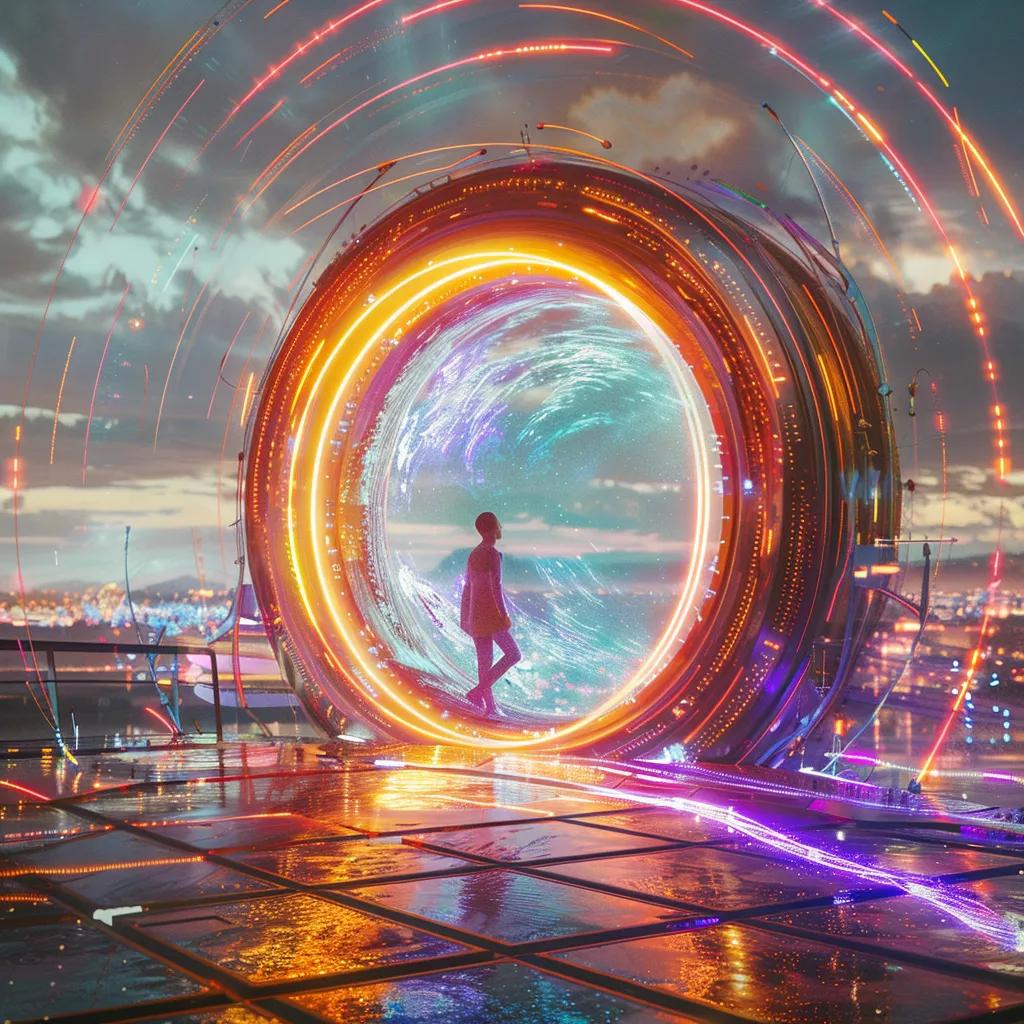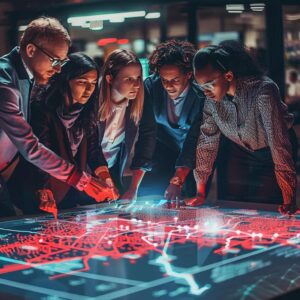How Teleportation Could Change Future Travel: Exploring Science, Society, Economy, And Ethics

Imagine stepping into a chamber and emerging continents away in an instant—this vision sits at the heart of the future of travel technology and promises to reshape every dimension of human mobility. This article delivers a deep dive into teleportation science explained, evaluates economic upheavals, unpacks societal transformations, assesses tourism revolutions, wrestles with moral dilemmas, and gauges human feasibility. You will gain clear insights into:
- The core principles behind how teleportation works and recent breakthroughs
- Economic disruptions and opportunities in global commerce
- Societal shifts in cities, work, borders, and security
- Tourism innovation and access to remote experiences
- Ethical and philosophical tensions around identity and privacy
- The real scientific barriers to human teleportation
Together, these themes map the full impact of teleportation on the future of travel technology and reveal what lies ahead.
What Is Teleportation And How Does It Work?
Teleportation transfers the exact quantum state of particles from one location to another, enabling information‐driven reconstruction without traversing space [Citation: Bennett et al., 1993]. This mechanism hinges on quantum entanglement, which links particle states across distances [Citation: Einstein et al., 1935], then uses classical communication to rebuild the original configuration—offering instantaneous transfer of information rather than matter [Citation: Bennett et al., 1993]. Understanding this process sets the stage for exploring its scientific limits and real‐world progress.
| Entity | Attribute | Value | Teleportation | Definition | Transfer of quantum information for remote reconstruction | Quantum Entanglement | Mechanism | Correlation of particle states across space | Classical Channel | Role | Conveys measurement results necessary for state reconstruction |
|---|
By anchoring teleportation in quantum theory, we can compare it to its more familiar sci-fi portrayal.
What Is The Difference Between Sci-Fi Teleportation And Quantum Teleportation?
Sci-fi teleportation often depicts instantaneous matter transfer of living beings, whereas quantum teleportation only moves information about a particle’s state. Real-world experiments reconstruct photons or atoms at a distant site but destroy the original quantum state in the process. This key distinction underscores that current science transfers data, not physical objects.
| Aspect | Sci-Fi Teleportation | Quantum Teleportation | Matter Transfer | Physical objects appear elsewhere | Only quantum information is transmitted | Conservation of Original | Original and copy coexist | Original state is measured and thereby destroyed | Technical Feasibility | Imaginative and unconstrained | Limited by quantum laws and technological barriers |
|---|
This comparison lays the groundwork for examining the enabling role of entanglement.
How Does Quantum Entanglement Enable Teleportation?

Quantum entanglement enables teleportation by creating a shared state between two particles, so that measuring one immediately defines the state of the other.
- Entanglement Preparation: Two particles are entangled in a laboratory.
- Bell Measurement: The sender performs a joint measurement on the entangled particle and the target particle, collapsing their states into a correlated outcome.
- Classical Communication: The measurement result is sent via a classical channel to the receiver.
- State Reconstruction: The receiver applies a specific quantum operation based on the measurement to reconstruct the original state on the distant particle.
These steps ensure accurate state transfer, but fundamental limits still apply.
What Are The Limitations Imposed By The Heisenberg Uncertainty Principle?
The Heisenberg Uncertainty Principle limits teleportation because it prohibits simultaneous precise knowledge of a particle’s position and momentum [Citation: Heisenberg, 1927]. As a result:
- Perfect state measurement is impossible, introducing reconstruction errors
- Increasing precision in one variable amplifies uncertainty in the conjugate variable
- Scaling to many-particle systems multiplies data complexity beyond current technology
These constraints define the frontier of teleportation research and highlight the difficulty of extending experiments from single photons to complex matter.
How Far Has Quantum Teleportation Advanced In Scientific Research?
Quantum teleportation has progressed from laboratory benches to satellite links over thousands of kilometers:
- In 2012, entangled photons were teleported across 100 km of optical fiber [Citation: Yin et al., 2012].
- In 2017, China’s Micius satellite demonstrated teleportation over 1,200 km between ground stations [Citation: Yin et al., 2017].
- Recent work integrates quantum channels with classical networks, paving the way for a quantum internet [Citation: Kimble, 2008].
Each milestone boosts confidence that teleportation science explained will evolve into practical infrastructure for secure communication and, one day, advanced transport platforms.
What Are The Economic Impacts Of Teleportation On Future Travel?
Teleportation will overhaul transportation and logistics by collapsing distance-related costs, fostering instantaneous commerce, and redefining global trade [Citation: World Economic Forum, 2020]. Disruption to established industries will be dramatic, but new sectors in quantum hardware, maintenance, and digital security will emerge—reshaping the future of travel technology into a carbon-light economy with novel revenue streams [Citation: IMO, 2020].
| Entity | Impact | Description | Airlines | Revenue Collapse | Instant travel eliminates long-haul flight demand | Shipping & Logistics | Operational Transformation | Goods move via quantum nodes rather than cargo ships, slashing delivery times and costs [Citation: McKinsey, 2018] | Quantum Infrastructure Services | Growth Explosion | Design, deployment, and maintenance of teleportation networks generate new high-skill job sectors [Citation: World Economic Forum, 2020] |
|---|
By reframing global supply chains and consumer behavior, teleportation unlocks instantaneous exchange and streamlines economic integration.
How Will Teleportation Disrupt Traditional Transportation And Logistics Industries?
Teleportation will render long-distance trucking, rail freight, and air cargo largely obsolete. Physical warehouses will diminish as goods teleport directly to distribution nodes. This shift will:
- Slash shipping times from days to seconds [Citation: McKinsey, 2018]
- Reduce warehousing and fuel expenses dramatically
- Force legacy carriers to pivot toward teleportation node operation and maintenance
These changes will transform capital investments and workforce needs across transportation ecosystems.
What Job Changes Will Teleportation Cause In The Global Economy?
As teleportation eliminates roles in driving, piloting, and freight handling, new careers will arise [Citation: World Economic Forum, 2020]:
- Quantum Network Engineers to design and secure entanglement channels
- Teleportation Safety Inspectors to certify node integrity and passenger protocols
- Data Architects specializing in encoding and error-correction of quantum states
Workers displaced from logistics may retrain into these emerging fields, fostering a skilled labor market around teleportation infrastructure.
How Could Teleportation Affect Global Trade And Market Integration?
Eliminating physical shipping barriers accelerates global market integration by:
- Leveling price disparities between regions
- Enabling real-time inventory management across continents
- Facilitating instant collaboration and remote manufacturing partnerships [Citation: McKinsey, 2018]
This frictionless commerce environment will deepen economic interdependence and boost productivity at unprecedented scale.
What Are The Potential Benefits Of Teleportation For Instantaneous Commerce?
Teleportation offers four primary economic advantages:
- Time Efficiency – Transactions and deliveries occur in seconds.
- Cost Reduction – Near-zero transportation and inventory holding costs.
- Carbon Footprint – Eliminates fossil-fuel emissions tied to shipping [Citation: IMO, 2020].
- Market Fluidity – Rapid responses to supply and demand fluctuations.
These benefits promise to enhance competitiveness, support sustainable practices, and unlock new business models in the future of travel technology.
How Will Teleportation Transform Society And Daily Life?
Teleportation will reshape where we live, how we work, and how communities interact by rendering physical distance irrelevant. Urban gravity may shift from dense city centers to distributed habitation nodes connected by teleportation hubs. This paradigm shift will redefine social structures and everyday routines.
| Entity | Attribute | Value | Urban Design | Spatial Distribution | From centralized skyscrapers to dispersed community micro-hubs | Social Interaction | Real-Time Connection | Dinner with friends on another continent in the evening | Border Policies | Regulatory Complexity | Nation-wide teleportation controls replace physical checkpoints |
|---|
These societal reconfigurations depend on equitable access, robust governance, and public trust in quantum systems.
What Changes Will Teleportation Bring To Urban Development And City Design?
Teleportation nodes will become focal points, replacing highways and airports as key infrastructure. Cities will:
- Decentralize into smaller residential clusters around teleportation hubs
- Convert vacant transport corridors into green spaces and pedestrian zones
- Integrate mixed-use developments that blend living, working, and teleportation access
This transformation fosters sustainable, human-scaled environments rather than car-dependent megacities.
How Could Teleportation Influence Work, Culture, And Social Interaction?
By enabling instant presence, teleportation will:
- Expand telecommuting into ‘tele-presence’, blurring remote and in-person work
- Accelerate cultural exchange and live participation in distant events
- Encourage hybrid social lives where personal and global communities merge seamlessly
These shifts will enhance collaboration but also challenge traditional notions of locality and community identity.
What Are The Implications Of A Borderless World Enabled By Teleportation?
A borderless world would require reimagined sovereignty and security. Teleportation could:
- Undermine traditional immigration controls and customs enforcement
- Foster global labor markets with near-instant job mobility
- Demand international treaties governing teleportation protocols and node access
Balancing open access with national security will become a defining geopolitical challenge.
How Might Teleportation Affect Security, Crime, And Warfare?
Teleportation technology introduces new risks and defense imperatives:
- Unauthorized Entry – Nodes could be breached to facilitate covert movement
- Teleportation-Based Smuggling – Contraband could bypass physical checkpoints
- Military Applications – Rapid deployment of personnel and equipment changes strategic doctrines
Robust encryption, authentication, and policy frameworks will be essential to mitigate these threats.
How Will Teleportation Impact The Future Of Tourism And Travel Experiences?

Teleportation will democratize exotic destinations by removing travel time and cost barriers, creating a new era of personalized, instantaneous tourism [Citation: UNWTO, 2021]. Visitors will experience remote wonders on a day trip, boosting cultural exchange and ecological awareness without the carbon toll of flights.
What Does Teleportation Mean For Travel Time And Accessibility?
Teleportation shrinks travel time to seconds, so:
- Remote landmarks become daily excursions
- Emergency medical evacuations occur instantly
- Accessibility for mobility-impaired travelers improves dramatically [Citation: UN, 2021]
Instant travel rewrites the rulebook on distance and inclusivity.
How Will Teleportation Change The Tourism Industry’s Business Models?
Tour operators will shift from booking flights and hotels to:
- Curating teleportation itineraries that sequence global attractions in hours
- Partnering with teleportation node operators for premium access and security
- Monetizing virtual plus physical experiences through mixed reality packages
New revenue streams will emerge from subscription-based teleportation travel plans.
What New Opportunities Could Arise In The Experience Economy?
Experience designers will craft multi-sense journeys combining teleportation with augmented reality, local gastronomy, and cultural immersion. This fusion will:
- Enable education-driven ‘time-travel’ tours to historical sites in situ
- Support micro-festivals that connect global artists with local audiences
- Foster eco-tourism that teleports small groups to fragile habitats without damage
These innovations will redefine how tourism enriches lives and economies.
What Are The Ethical And Philosophical Questions Raised By Teleportation?
Teleportation confronts fundamental ideas of identity, consent, and privacy by creating perfect copies or reconstructing consciousness from data. As we translate human beings into information, deep questions arise about personhood, moral responsibility, and governance of this transformative power.
What Is The Teleportation Paradox: Original Vs. Copy?
The teleportation paradox asks whether the person at the destination is the same as the original. If the process destroys the original quantum state to rebuild a copy, consciousness continuity becomes debatable [Citation: Parfit, 1984]. Many philosophers argue that the original’s subjective experience ends at measurement, while the copy inherits only an identical pattern, raising ethical questions about mortality and selfhood.
How Does Teleportation Challenge Our Understanding Of Life And Death?
By turning people into reconstructable data, teleportation blurs the line between death and relocation. If identity depends on information patterns, then death could be reframed as irreversible data loss. This perspective requires reexamining end-of-life ethics, digital immortality, and the sanctity of human consciousness.
What Security And Privacy Risks Does Teleportation Pose?
Teleportation networks handle vast amounts of personal and biometric information, exposing risks such as:
- Data Breaches of quantum state records that reveal intimate biological details
- Unauthorized Duplication of sensitive individuals or objects
- Surveillance Abuse through forced or covert teleportation scans [Citation: European Data Protection Board, 2019]
Protecting individual autonomy demands robust encryption standards and transparent oversight.
How Could Teleportation Be Regulated To Address Ethical Concerns?
Effective regulation will combine technical protocols and global agreements:
- International treaties defining consent, liability, and node usage rights
- Licensing frameworks for teleportation operators with safety and privacy audits
- Ethical review boards to assess applications involving human subjects
A multi-stakeholder approach, including scientists, ethicists, and policymakers, will underpin responsible deployment.
Is Human Teleportation Possible? What Are The Scientific And Practical Challenges?
Human teleportation remains a theoretical concept constrained by immense data requirements, the uncertainty principle, and philosophical questions of identity. While quantum experiments succeed at particle scales, scaling to a human body involving over 10^28 atoms presents insurmountable barriers in measurement, information processing, and ethical acceptance [Citation: Calude & Pavlov, 2019].
Why Is Scanning A Human Body For Teleportation So Difficult?
Scanning every particle in a human body requires capturing position and momentum data far beyond current sensor resolution. The resulting dataset would exceed all existing computational storage, and the destruction of living tissue during measurement raises existential and ethical dilemmas.
How Does Current Science View The Possibility Of Human Teleportation?
Most physicists agree that while quantum networks will enable secure communication, teleporting a conscious human is not feasible with foreseeable technology [Citation: Preskill, 2018]. Research prioritizes quantum computing and cryptography over matter teleportation due to practical constraints.
What Are The Key Scientific Principles Limiting Human Teleportation?
The main limiting principles include:
- Heisenberg Uncertainty – prohibits perfect state measurement [Citation: Heisenberg, 1927]
- No-Cloning Theorem – disallows creating identical quantum copies [Citation: Wootters & Zurek, 1982]
- Data Complexity – renders reconstruction algorithms computationally prohibitive
These factors collectively uphold teleportation as a landmark communication tool, not a mode of human transport—at least for now.
Frequently Asked Questions About Teleportation And Future Travel
People often wonder whether teleportation is merely science fiction or a looming reality. The core inquiries revolve around feasibility, traveler benefits, economic shifts, ethical tensions, and industry disruption. The following concise insights clarify these themes without resorting to question-and-answer lists.
Is Human Teleportation Really Possible Today?
Human teleportation is not possible today. Existing experiments teleport quantum states of photons and atoms, not living beings. Fundamental physical limits and astronomical data requirements prevent reconstructing a human body’s exact quantum configuration.
What Are The Main Benefits Of Teleportation For Travelers?
Teleportation offers near-instant travel, eliminating transit delays and logistical complexities. Travelers would enjoy seamless access to distant locations, reduced carbon footprints, and personalized itineraries that adapt in real time.
How Will Teleportation Affect The Economy And Jobs?
Teleportation will collapse transportation costs, disrupt airlines and shipping, and create new roles in quantum network engineering, security, and node operations. The global economy will shift toward high-skill, tech-centered industries.
What Ethical Problems Are Associated With Teleportation?
Key ethical issues include identity continuity versus copy, privacy risks from biometric data exposure, and the moral status of replicated individuals. Governance frameworks must address consent, security, and responsibility for unintended harms.
How Will Teleportation Change The Tourism Industry?
Tourism will transform into an on-demand experience economy where remote sites become accessible in seconds. Operators will design teleportation-based packages that blend physical immersion with digital enhancements, redefining cultural and ecological tourism.
Teleportation stands at the crossroads of ambition and ethics. Its promise to redefine distance and connectivity is matched by profound challenges in physics, governance, and identity. As research continues to advance teleportation science, society must balance innovation with responsibility to shape a future where travel transforms opportunity without fracturing the human bond.






